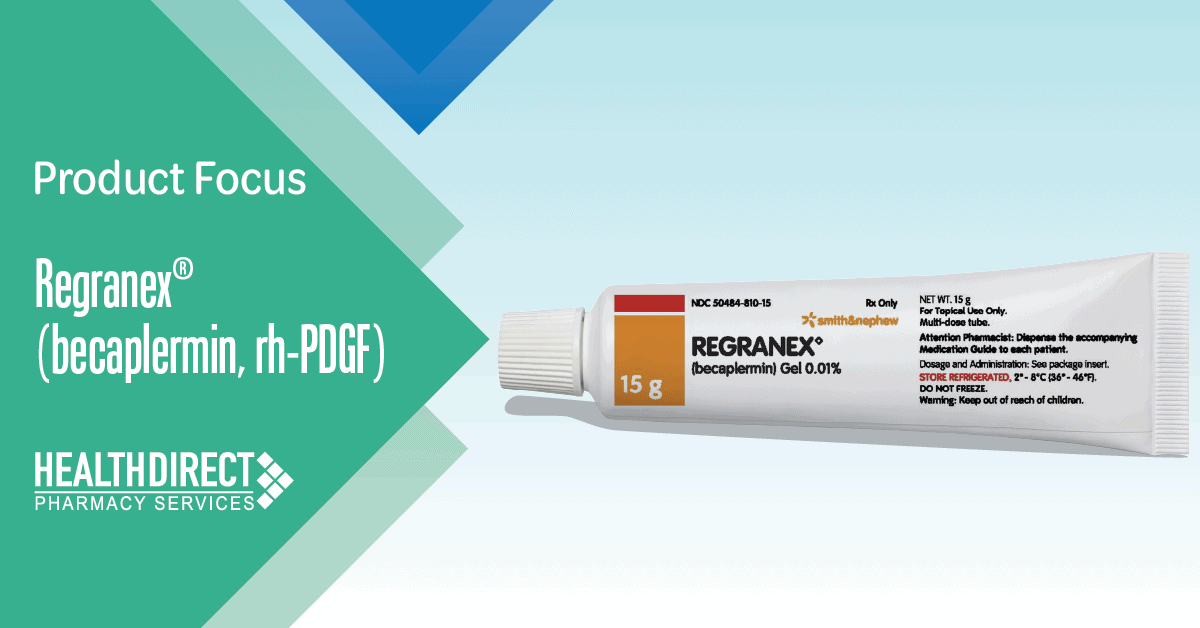REGRANEX® (BECAPLERMIN) GEL IS BACK IN STOCK FROM SMITH & NEPHEW, INC
Description:
REGRANEX® gel is the only FDA-approved PDGF for the treatment of diabetic neuropathic ulcers, formulated to act as a first-line treatment following effective ulcer care. REGRANEX®
gel features endogenous platelet-derived growth factor (PDGF) therapy, shown to initiate the healing process by attracting repair cells to the wound.
PDGF works to:
- Stimulate fibroblast proliferation to increase the growth of granulation tissue
- Increase the rate of re-epithelialization and revascularization
- Promote collagen production
Indications:
REGRANEX® (becaplermin) gel 0.01% (“REGRANEX”) is indicated for the treatment of lower extremity diabetic neuropathic ulcers that extend into the subcutaneous tissue or beyond and have an adequate blood supply, when used as an adjunct to, and not a substitute for, good ulcer care practices including initial sharp debridement, pressure relief and infection control.
Topical Dosage:
Adults and Adolescents at least 16 years of age.
The recommended dose is one application left in place for 12 hours once daily. The amount of gel to be used is determined by ulcer size.
Contraindications:
REGRANEX® is contraindicated in patients with known neoplasm(s) at the site(s) of application.
Warnings and Precautions:
Malignancies distant from the site of application have occurred in REGRANEX® users in a clinical study and in post-marketing use. REGRANEX® contains becaplermin, a recombinant human platelet-derived growth factor, which promotes cellular proliferation and angiogenesis. The efficacy of REGRANEX® has not been established for the treatment of pressure ulcers and venous stasis ulcers and has not been evaluated for the treatment of diabetic neuropathic ulcers that do not extend through the dermis into subcutaneous tissue or ischemic diabetic ulcers. The effects of becaplermin on exposed joints, tendons, ligaments, and bone have not been established in humans. REGRANEX® is a non-sterile, low bioburden preserved product. Therefore, it should not be used in wounds that close by primary intention.
Adverse Reactions:
In clinical trials, erythematous rashes occurred in 2% of subjects treated with REGRANEX® (and good ulcer care) or placebo (and good ulcer care). In a retrospective follow-up study, eight of 291 subjects (2.7%) from the REGRANEX® group, and two of 200 subjects (1%) from the placebo group were diagnosed with cancers during the follow-up period. An increased rate of death from systemic malignancies in patients dispensed three or more tubes of REGRANEX®, observed in one of three retrospective post-marketing studies. Other adverse reactions that have been reported include a burning sensation, and erythema at the site of application.
Pharmacokinetics: Topical Route
Ten patients with Stage III or IV lower extremity diabetic ulcers as defined in the International Association of Enterostomal Therapy guide to chronic wound staging received 0.32—2.95 mcg/kg (7 mcg/cm2) of becaplermin 0.01% gel daily to the ulcer for 14 days. Six patients had non-quantifiable platelet-derived growth factor (PDGF) concentrations at baseline and throughout the study, 2 patients had PDGF concentrations at baseline that did not increase substantially, and 2 patients had PDGF concentrations that increased sporadically above their baseline values over the 14 days.
How Supplied:
REGRANEX® (0.01%) is clear, colorless to straw-colored and is available in multi-use tubes in the following
size: 15 g tube.
NDC 50484-810-15 Store refrigerated at 2° – 8°C (36° – 46°F). Do not freeze.

Efficacy:
Shown to achieve faster healing and a greater incidence of wound closure
In clinical studies, using REGRANEX® gel as part of effective ulcer care:

Helped to achieve wound closure an average 6 weeks earlier than placebo gel.

Significantly increased the incidence of complete closure by 43%, when compared to placebo gel.

Shown to help stimulate the recruitment and proliferation of cells involved in wound repair.
Now to calculate dosage
The correct dosage for REGRANEX® Gel can be calculated using these simple formulae:
Ulcer length (cm) x Ulcer width (cm) ÷ 4 = length of gel per application (cm)
Alternatively:
Ulcer length (in) x ulcer width (in) x .6 = length of gel per application (in)

In the event of multiple wounds, each wound should be assessed individually. Recalculate dose weekly or bi-weekly, based on the rate of change in the ulcer area.
How to estimate the required number of tubes
To estimate the number of tubes required, use this simple calculation:
Length of gel per application (cm) x Estimated length of therapy (days) ÷ (60cm/tube) = estimated number of tubes required
Example:
Based on a 2cm x 3cm ulcer.
(1.5cm) x (14 days) ÷ 60cm/tube = 0.35 tubes
Order 1 tube, rounding up to the nearest full tube.
- The days of therapy per tube are calculated based on a constant ulcer size and may change based on decreasing wound size as ulcer heals.
- If the ulcer does not decrease in size by approximately 30% after 10 weeks of treatment, or complete healing has not occurred in 20 weeks, continued treatment with REGRANEX® gel should be reassessed

A clinical study showed that diabetic foot ulcer patients treated with REGRANEX® gel received an average 1.5 tubes.
References:
- https://www.smith-nephew.com/professional/products/all-products/regranex/
- Regranex® (becaplermin) gel package insert. Fort Worth, TX: Smith & Nephew, Inc; 2019 Aug




